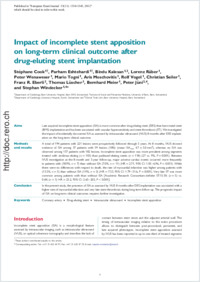Impact of incomplete stent apposition on long-term clinical outcome after drug-eluting stent implantation
- Cook, Stéphane Department of Cardiology, University Hospital, Bern, Switzerland
- Eshtehardi, Parham Department of Cardiology, Bern University Hospital, Bern 3010, Switzerland
- Kalesan, Bindu Department of Cardiology, Bern University Hospital, Bern 3010, Switzerland
- Räber, Lorenz Department of Cardiology, Bern University Hospital, Bern 3010, Switzerland
- Wenaweser, Peter Department of Cardiology, Bern University Hospital, Bern 3010, Switzerland
- Togni, Mario Department of Cardiology, Bern University Hospital, Bern 3010, Switzerland
- Moschovitis, Aris Department of Cardiology, Bern University Hospital, Bern 3010, Switzerland
- Vogel, Rolf Department of Cardiology, University Hospital, Bern, Switzerland
- Seiler, Christian Department of Cardiology, University Hospital, Bern, Switzerland
- Eberli, Franz R. Department of Cardiology, University Hospital, Zurich, Switzerland
- Lüscher, Thomas Department of Cardiology, University Hospital, Zurich, Switzerland
- Meier, Bernhard Department of Cardiology, University Hospital, Bern, Switzerland
- Jüni, Peter Institute of Social and Preventive Medicine, University of Bern, Switzerland - Clinical Trials Unit, University Hospital, Bern, Switzerland
- Windecker, Stephan Department of Cardiology, University Hospital, Bern, Switzerland - Clinical Trials Unit, University Hospital, Bern, Switzerland
-
26.01.2012
Published in:
- European Heart Journal. - 2012, vol. 33, no. 11, p. 1334-1343
English
Aims Late acquired incomplete stent apposition (ISA) is more common after drug- eluting stent (DES) than bare metal stent (BMS) implantation and has been associated with vascular hypersensitivity and stent thrombosis (ST). We investigated the impact of incidentally discovered ISA as assessed by intravascular ultrasound (IVUS) 8 months after DES implantation on the long-term clinical outcome.Methods and results A total of 194 patients with 221 lesions were prospectively followed through 5 years. At 8 months, IVUS showed evidence of ISA among 37 patients with 39 lesions (18%) (mean ISAmax 4.7 ± 5.0 mm2), whereas no ISA was observed among 157 patients with 182 lesions. Incomplete stent apposition was more prevalent among segments treated with sirolimus-eluting (n = 103) than paclitaxel-eluting stents (n = 118) (27 vs. 9%, P = 0.001). Between IVUS investigation at the 8-month and 5- year follow-up, major adverse cardiac events occurred more frequently in patients with (18.9%, n = 7) than without ISA (7.0%, n = 11) (HR = 2.71, 95% CI: 1.05–6.96, P = 0.031). While there were no differences with respect to death, the rate of myocardial infarction was higher among patients with (13.5%, n = 5) than without ISA (1.9%, n = 3) (HR = 7.53, 95% CI: 1.79–31.6, P = 0.001). Very late ST was more common among patients with than without ISA [Academic Research Consortium-definite ST:13.5% (n = 5) vs. 0.6% (n = 1) HR = 23.2, 95% CI: 2.65–203, P < 0.001].Conclusion In the present study, the presence of ISA as assessed by IVUS 8 months after DES implantation was associated with a higher rate of myocardial infarction and very late stent thrombosis during long-term follow-up. The prognostic impact of ISA on long- term clinical outcomes requires further investigation.
- Faculty
- Faculté des sciences et de médecine
- Department
- Médecine 3ème année
- Language
-
- English
- Classification
- Medicine
- License
-
License undefined
- Identifiers
-
- RERO DOC 31197
- DOI 10.1093/eurheartj/ehr484
- Persistent URL
- https://folia.unifr.ch/unifr/documents/302804
Statistics
Document views: 112
File downloads:
- pdf: 229
